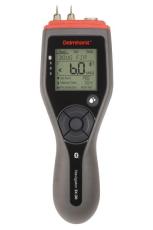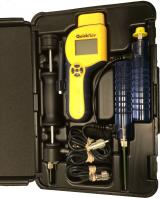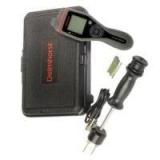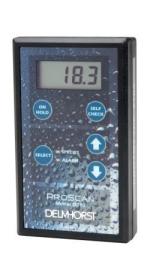
FAQs about hay moisture measurementHay moisture meters - questions & answers |
|
Why should I use a moisture tester? Moisture content is one of the most important variables — and challenges — the high quality hay producer must face. Baling at proper moisture levels is critical to the hay grower’s objective — to bale and store hay in a manner to reduce mold development and at the same time preserve leaves, color, and feed value. Using a moisture tester is the only way a farmer can be sure that his hay is being baled at the ideal moisture levels. How does a moisture meter operate? Most probe-type meters operate on the principle of electrical resistance, utilizing the relationship between the moisture content of the material and its conductivity. This relation is possible because moisture is an effective conductor of electricity and hay acts as an effective insulator. The "reading" is made between the two metal contacts at the tip of the probe. At what moisture range can hay be baled? Traditionally, the recommended moisture content for baling hay without a preservative is between 18-20%. If using a preservative, follow the instructions set forth by each particular preservative manufacturer. Smart use of a moisture tester in combination with preservatives and drying agents allows hay to be baled at higher than traditionally recommended moisture levels. In either case, do not attempt to bale hay before it is at an acceptable moisture level, even when using a preservative. What methods are commonly used for testing hay moisture?
What affects the meter readings? Besides moisture content, factors which affect meter readings most are: moisture distribution, crop variety, temperature of the hay, crop maturity, sample density, cutting, and the overall climatic conditions present. Cloud cover and high relative humidity result in more variable moisture readings than a sunny, dry day with light breezes. How can I know I'm receiving the most accurate results? Because field conditions can change rapidly, accuracy guidelines must be considered in terms of "ranges", not specific points. Claims of accuracy should be taken with caution, because it is unlikely that such claims can be consistent. Expert evaluations of the same meter may yield different results, mainly dependent on the technician’s sampling procedure, conditioning and uniformity of the samples, difference in crop, and differences in oven test procedure. For optimum results, carefully read the owner’s manual provided with each meter. Is there a way to make sure my meter is in calibration? The primary or electrical calibration of the tester can easily be checked by the built-in calibration checkpoint feature or by using an optional moisture content standard. How do I keep a Delmhorst meter in good working condition? Delmhorst moisture meters are well known for their ruggedness and ability to withstand years of rough handling. Like any testing instrument, a little care goes a long way toward trouble-free service:
If you have any further questions on using a hay moisture meter, please call us at +31 73 6395080 or send us an e-mail. Top |
 |










